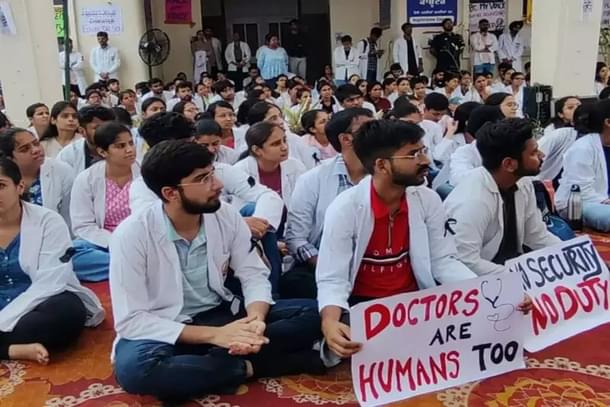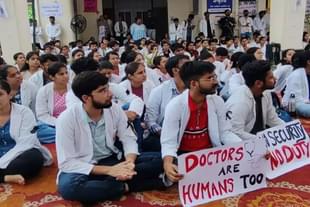West Bengal
Here’s How Junior Doctors’ Demand For Security Exposes The Deep Rot In Bengal’s Public Healthcare System
Jaideep Mazumdar
Sep 29, 2024, 04:50 PM | Updated 04:48 PM IST
Save & read from anywhere!
Bookmark stories for easy access on any device or the Swarajya app.


The brutal rape-murder of a postgraduate intern at RG Kar Medical College Hospital in Kolkata on 9 August had triggered not only outrage across the country, but a 42-day-long ‘ceasework’ by junior doctors in the 27 government-run medical college hospitals across Bengal.
Adequate security at their workplaces was the primary demand of the junior doctors, who resumed work on 19 September after a meeting with Chief Minister Mamata Banerjee and then with the state chief secretary.
Doctors serving in state-run hospitals in Bengal are a highly vulnerable group who come under frequent physical attacks by relatives and friends of patients who allege negligence.
The state government has repeatedly assured doctors of security, but every attack on doctors and even paramedical staff at government hospitals reveals the hollowness of such assurances.
Chief Minister Banerjee had personally held out this assurance many times. Police have been posted at government hospitals, CCTV cameras installed and some other measures taken.
But these have proved to be grossly ineffective because of the deep rot that is afflicting the public healthcare system under Banerjee’s direct watch (she is also the Health Minister).
Late last week (Friday, 27 September), even as the West Bengal Junior Doctors Front (WBJDF) was contemplating its future course of action, relatives of a dengue patient who died at the state-run College of Medicine and Sagore Dutta Hospital (CMSDH) at Kamarhati in the northern limits of Kolkata went on a rampage and assaulted junior lady doctors and nurses there.
A police contingent posted at the hospital reportedly looked the other way as relatives of deceased patient ransacked parts of the hospital and assaulted three lady doctors and nurses. The attackers alleged that the patient had died due to lack of proper treatment.
The hospital authorities have denied this and said that the patient was brought in a critical condition from another district.
The assault — one in a long line of similar attacks on doctors and nurses in Bengal — led to an immediate strike by junior doctors at the CMSDH on Friday evening.
The WBJDF threatened on Saturday (28 September) evening that it would resume its complete ‘ceasework’ from Monday (30 September) evening if the Banerjee government “does not demonstrate its seriousness” in ensuring safety of doctors and paramedical staff in hospitals.
“We will revert to complete cease-work from 5pm on Monday if the government fails to implement the security measures that had been decided at an earlier meeting. The assault on our colleagues happened on Friday when WBJDF was at a mass convention discussing issues of security and threat culture. This incident has proved that the state government has failed to instil confidence in us so that we can return to our duties,” said WBJDF’s Anustup Mukherjee.
“The Supreme Court had also told the government to ensure confidence-building measures among medical staff. But we don’t see much of that happening on the ground. This incident (at CMSDH) is an example of it,” said Aniket Mahata, another leader of the WBJDF.
The state government will, expectedly, try to placate the doctors and announce another set of measures like fast-tracking the installation of CCTV cameras in state-run hospitals, posting more cops in hospitals, etc.
Whether another set of assurance from the state government placates the junior doctors will work remains to be seen, but what is certain is that attacks on doctors and nurses by relatives and friends of patients will continue in Bengal.
That’s because the public healthcare system is in a complete mess in the state and doctors, especially junior doctors as well as paramedical staff, are soft targets who will continue to bear the brunt of the state government’s inaction and misdeeds.
The three primary reasons why attacks on doctors will continue are:
1. The perpetrators of these attacks are invariably from the lower and lower middle classes and they constitute Banerjee’s vote bank.
Also, in many such cases, the guilty are Muslims who form the Trinamool’s core vote bank. There is no way Banerjee will take any action that will anger her vote banks.
That’s why most attackers go scot free and even the ones that are booked are let off lightly. Weak chargesheets, if at all, are framed against them and they get bail and are eventually acquitted easily.
The police personnel posted in state-run hospitals have standing orders against “using excessive force” on relatives/friends of patients who attack doctors and nurses because the ruling party cannot afford to anger its vote banks.
The abject failure of the state government to take punitive and exemplary action against the attackers in the past has only emboldened patients’ relatives and friends who feel aggrieved or are bereaved to vent their ire on doctors and nurses.
The attackers know that they can easily get away and so they feel it is no big deal to attack doctors and nurses.
After Friday’s attacks on doctors and nurses at CMSDH, police arrested four relatives of the patient. That has already triggered protests at the locality in Liluah where the accused stay.
It is only a matter of time before local Trinamool leaders get involved and, in order to appease the protestors who inevitably form their loyal support base, lean on their senior party leaders to apply pressure on the police to water down the case against the attackers.
Ultimately, the attackers will get bail within a few days and the case will drag on in courts for months, if not years. And at the end of it all, the accused will be acquitted because the police will fail to present a strong chargesheet.
2. Almost all the patients who are rushed to the medical college hospitals are already in a critical condition.
Primary health centres (PHCs), and healthcare centres at the block and even district levels are woefully understaffed and lack proper equipment and even lifesaving medicines.
The state government just does not have the funds to recruit more doctors and paramedics or provide even basic equipment and medicines to PHCs and hospitals at the block, sub-division and district levels.
As a result, the condition of patients who are admitted to these public healthcare facilities deteriorate due to lack of adequate and timely care and treatment. Once their conditions deteriorate, they are quickly referred to the state-run medical college hospitals.
The state-run medical college hospitals are also grossly understaffed and lack adequate facilities, including beds in ICUs, to cope with the huge rush of patients from all over the state.
Junior doctors and nurses struggle to cope with this rush of patients at the medical college hospitals and are often overwhelmed. Very often, they can do little to revive the critically-ill patients that they receive. When such patients die while under treatment, the bereaved relatives and friends often turn on the doctors and nurses because they are the softest targets.
This was the case at the CMSDH as well. The patient — a 30-year-old lady from Liluah in Howrah district — was suffering from dengue since Tuesday (17 September) and was admitted to a PHC there. When her condition deteriorated on Friday, she was referred to the CMSDH at Kamarhati.
When she was admitted at the CMSDH, she was already in a critical condition and required to be shifted to the intensive care unit (ICU), but there were no vacant beds at the ICU. Doctors at the hospital said that despite their best efforts, the lady died.
“Doctors and nurses who were on duty tried their best to save the patient, but she died,” said CMSDH medical superintendent Sujay Mistry.
3. Friday’s incident at the CMSDH exposes the systemic shortcomings and failures in the state healthcare system.
First, the PHC at Liluah should have been able to treat a dengue case when the patient reached the centre. But it couldn’t because it was short-staffed and lacked proper equipment and facilities to diagnose the treat dengue.
Had the PHC at Liluah been able to diagnose that the patient was afflicted with dengue right after she was admitted early last week, the doctors there should have been able to save her.
Instead, she was diagnosed with dengue only after her condition turned critical after three days. And once that happened, the doctor at the PHC referred her to the CMSDH instead of the Howrah District Hospital.
The reason why she was not referred to the Howrah District Hospital is that the doctor at the PHC knew that the district hospital also would not be able to save the critically ill patient. Hence, she was referred to the CMSDH.
But the CMSDH also had no beds in the ICU available when there ought to have been an adequate number of such beds available since the hospital caters to a huge number of patients from surrounding districts.
All this means that all government healthcare centres from the PHCs to the super-specialty hospitals lack infrastructure, staff and facilities.
A huge infusion of funds running into thousands of crores of rupees is required to purchase expensive equipment, expand infrastructure and recruit more doctors and other staff at government hospitals in Bengal.
But Bengal, which is reeling under debt, just does not have that sort of money.
And that, unfortunately, is why doctors and nurses will continue to come under attack for no fault of their own but due to the inability of the state government to stem the rot afflicting public healthcare in Bengal.
And that is why it is only a matter of time before another attack on doctors in yet another government hospital takes place, or another doctor is physically abused and murdered.





